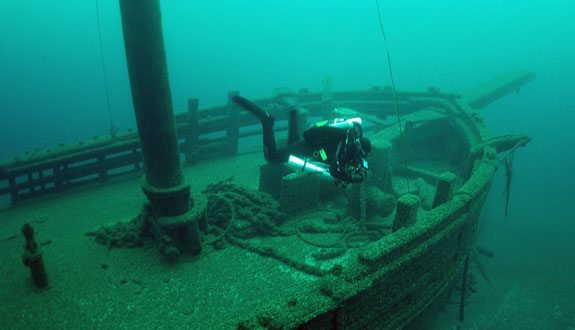
NMSF Applauds Plans to Designate Wisconsin-Lake Michigan National Sanctuary
Contact: Shannon Yee, shannon@marinesanctuary.org, 202-870-0387
Washington, DC; January 6, 2017 — The National Marine Sanctuary Foundation applauds the National Oceanic and Atmospheric Administration’s (NOAA) release of the draft plan to designate 1,075 square miles of Lake Michigan in Wisconsin as a new national marine sanctuary.
The draft plan calls for the protection of 37 historic shipwrecks, 18 of which are listed on the National Register of Historic Places, and as many as 80 more shipwrecks are yet to be discovered. Specifically, the proposed sanctuary protects two of Wisconsin’s oldest shipwrecks along with several wrecks that are almost completely intact, including some with their masts miraculously standing, still towering over the lakebed.
For centuries, the icy cold waters of Lake Michigan served as a treacherous gateway for communities, commerce and trade that drove the prosperity and expansion of our Nation. Wisconsin’s maritime heritage runs deep with more individually listed shipwrecks on the National Register of Historic Places than any other state. These shipwrecks and cultural artifacts are important pieces of American history and represent the tenacity and entrepreneurial spirit of generations of Americans.
“The Wisconsin-Lake Michigan national marine sanctuary designation would preserve nationally significant shipwrecks, allows explorers to uncover their stories, and honor their contributions to shaping our nation,” said Kris Sarri, President and CEO of the National Marine Sanctuary Foundation. “Tall ship festivals, maritime heritage trails, vibrant working waterfronts and museums and exhibits attract visitors and tourists bringing these wrecks back to life and contributing to local economy.”
“Establishing a national marine sanctuary represents the long standing broad-based support from local governments, state agencies, elected officials, community partners, and user groups”, said Wisconsin Department of Administration Secretary Scott Neitzel. “A sanctuary would have a positive local economic impact by increasing the recognition and visibility of the Great Lakes in Wisconsin’s history.”
The State of Wisconsin, in conjunction with the communities of Port Washington, Sheboygan, Manitowoc and Two Rivers, submitted the sanctuary nomination with strong bipartisan, community backing, including more than 60 letters of support. A diverse coalition of federal, state and local elected officials; historical societies; businesses; museums; and environmental, recreational, conservation, fishing, tourism and educational groups support the designation. Together, these partners will utilize innovative and cutting edge technologies for research and exploration to connect maritime museums, state and local parks, and school districts to these wonders and to Great Lakes history while advancing Science Technology Engineering and Math (STEM) education to promote job skills and opportunities for the next generation.
NOAA is holding public meetings and accepting public comments on the draft plans through March 31, 2017.
NOAA also announced today the release of a draft plan to designate 52 square miles centered around Mallows Bay along the Potomac River in Maryland as new national marine sanctuary. If the two new sites are designated, the National Marine Sanctuary System will expand to 17 sites conserving over 621,000 square miles of America’s oceans and Great Lakes.
“The release of the draft plans for Wisconsin-Lake Michigan and Mallows Bay-Potomac River builds on the historic progress made in 2016 on ocean and Great Lakes conservation. Designation of these two unique areas as sanctuaries would mark the first time in 15 years that the Nation added to our marine and Great Lakes sanctuary system. Widespread and enthusiastic support at the local and state levels makes these sanctuary designations possible,” said Sarri.
The National Marine Sanctuary System includes 13 national marine and Great Lakes sanctuaries and two marine national monuments. These unique waters sustain critical, breathtaking marine habitats that provide homes to endangered and threatened species. They preserve America’s rich maritime heritage. And they are living laboratories for science, research, education, and conservation. Sanctuaries also offer world-class outdoor recreation experiences for all ages and support local communities by bringing billions of dollars to their economies. Communities across the nation look to sanctuaries to protect nationally significant areas of our ocean, coasts, and Great Lakes.
As the chief national not-for-profit partner for marine and Great Lakes sanctuaries, the National Marine Sanctuary Foundation (NMSF) works to conserve these unique areas. The Foundation supports research and conservation, education, citizen science, outreach and community engagement.
